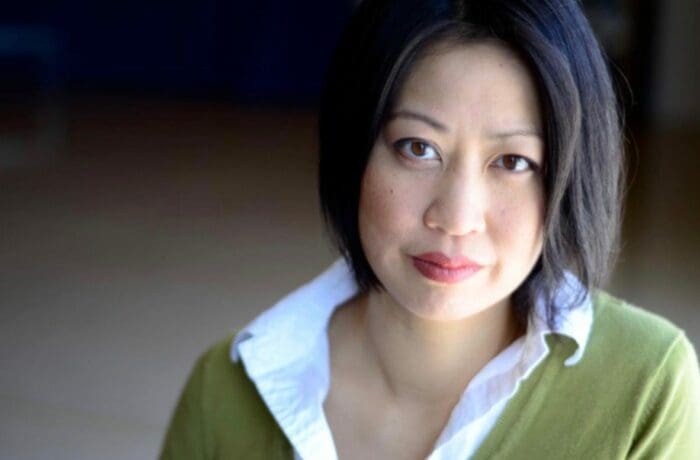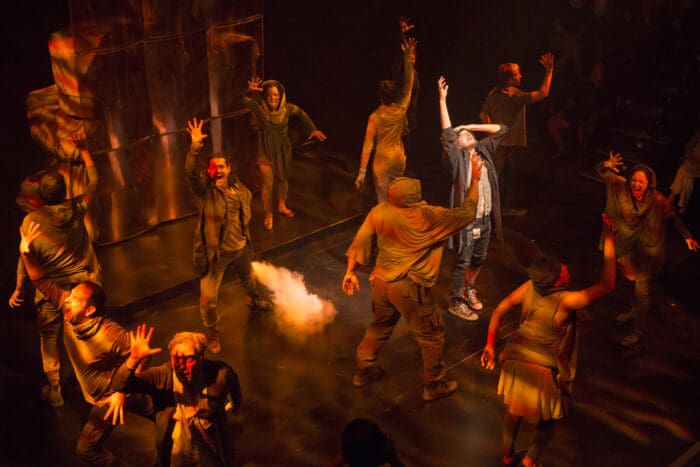 Before we announce the winners of the 2016 MyTheatre Awards, we’re proud to present our annual Nominee Interview Series.
Before we announce the winners of the 2016 MyTheatre Awards, we’re proud to present our annual Nominee Interview Series.
Canada’s biggest and most famous theatre company- The Stratford Festival- sometimes gets bogged down by its traditional style and aging demographics. Outstanding Direction nominee Keira Loughran rejected all of the stodginess that plagues the festival with her bold, physical, diverse and politically relevant version of The Aeneid, breathing the freshest of air into the season.
 Can you remember your first experience with theatre?
Can you remember your first experience with theatre?
My PoPo was a big patron of the arts and took all us grandkids to the see the National Ballet regularly. She had front row seats for everything. I loved watching the dancers – they were so beautiful and graceful, but I could also see the sweat on their brows and how they would slouch off into the wings once they had made their exits. I loved the dichotomy of that. She also took us to Ross Petty’s pantomimes when he first started doing them and because our seats were so close, I usually got to be one of the kids he would bring onstage at the end of the show.
What first drew you to the directing?
I went to a school for the arts from a very young age, so performing was something I was quite familiar with, but it wasn’t until I first learned about and studied a whole roster of seminal theatre directors in grade 12 that I understood the idea of artistic vision and the social and political act inherent in making theatre. This understanding of the craft of theatre led me to the decision to make it my vocation, and being a director within that business was always where I thought I would do my best work.
How do you pick your projects? Do you choose them with a specific vision in mind?
I have been offered particular projects more often than having the privilege of picking a project outside of a self-producing model. I think there are only a handful of freelance directors in Canada who can successfully pitch a project to an Artistic Director, compared to the number of talented directors in the country. I have also been working full-time at Stratford and raising my two kids so I haven’t had a lot of time to dream about potential projects. That being said, I have come across the occasional script, either a new work or old, that touches or speaks to me quite deeply, or stirs my imagination in an immediate and vivid way. Then I have dared to hope to have the chance to direct it. The Aeneid was one of those, as was Pu-Erh for which I was nominated for a Dora award. In those cases I usually do have a strong and specific vision in mind, but it feels more like the project dictates that and chooses me, rather than me choosing it.
Where did you find your inspiration for your MyTheatre Award-nominated production of The Aeneid?
I loved the script the first time I encountered it, which was back in 2007. The idea within it that resonated with me immediately was Olivier [Kemeid]’s premise of re-envisioning the heroic founder of Rome as a refugee – some of the world’s most marginalized people. The other aspect of the script that struck me immediately was that the story was not being told through the words alone – it seemed to me that there was space within the script that was deliberately left to be filled with something else: movement, music – in order to create the broader world of the play. I was excited by what that might be.

The Aeneid was a very physical piece. Is movement usually a key part of your work?
Yes. I did a lot of dance and rhythmic gymnastics when I was a growing up and have continued to train physically all my life. I also saw more physical performance than live theatre or even television or film – the ballet, Chinese acrobats, figure skating. It developed my eye and understanding, though I didn’t realize it at the time, of physical narrative and dramaturgy. My physical training now is primarily aikido which I have been doing for over 20 years. I have a second degree black belt in it and teach it in Stratford. That journey has informed me a lot about what it is to be an artist and it has also influenced my process of creation as well. The first play I wrote, directed and performed in – Little Dragon – was conceived to be staged using a physical vocabulary of aikido, contact dance and tableaux. That being said, I don’t want to be the director who always does physical theatre, and truthfully, my work is like physical theatre lite, but I do find that developing a physical language through training in a rehearsal process gives the company more tools with which to build the world of the play together, and to heighten their work within it. So even if a play is naturalistic, there is usually a robustness or heightened specificity to the physical actions of the performers in my productions.
Walk me through casting- was the play chosen with the actors in mind?
No, this play was developed over three years at Stratford and many amazingly talented actors contributed to the final production in these workshops, and could easily have populated the final cast as successfully as the cast we had. As a repertory company, the demands of the other shows and the desires of the other directors always necessitates negotiation. For this show, we cast Gareth [Potter] early on, who had been in a previous workshop and who, for me, just was my Aeneas. In addition to the emotional attunement he had to the role, he was also versed in the physical language and process I was drawing from, and it was incredibly helpful to have such a seasoned actor in that anchoring role. In casting him as Aeneas, it became crucial to have the rest of the ensemble not just culturally diverse, but also to create a company who would be game to bring their diverse experience with regards to immigration, and add it to the complexity of the story we were trying to tell. I was also looking for people who had some vocal skills as I wanted to explore Carnatic music, and who were interesting movers and were in their bodies, but who were not necessarily dancers.
What’s your rehearsal process like?
It’s different for every show. I believe quite strongly that each process needs to be uniquely crafted to the needs of the story. I do look, however, for three different modes of working within a process – company training, personal and group devising, and scenework. Company training is a useful way to establish ensemble, get everyone breathing – in action and in the moment – together. It’s the living practice of what each performance should be. Personal and group devising gives time for the actors to investigate within themselves how some of the larger and complex ideas and themes in the play feel and can be expressed in ways other than through the text. It can develop a physical language that belongs to the story and might be incorporated into staging. It demands a degree of vulnerability and generosity, which are two traits I value highly in a performance. Including these two components into rehearsal also creates some efficiency, I find, when it comes to scenework. The actor has more to draw on already and is more open to responding organically and spontaneously to their impulses, rather than things like stage directions or intellectual logic and being a “good” scene partner. That being said, solid scene work is also integral.
What did you bring to the play that was a departure from the script as written?
For me, the figure of Ascanius – Aeneas’ son – took on a greater significance than Olivier’s original script implies. So many immigrants and refugees make the journey to give their children a better life. And thinking about how children might experience the journey to a new home – the things they are witness to, and how they process or remember that as they get older – that fascinated me. Also, as a third-generation Chinese-Canadian, much of my family’s story has been lost due to time, geography, and cultural shame or neglect. I wanted to encourage us, as Canadians, to listen and engage with the stories, as horrific as they might be, of the refugees who are currently arriving on our shores. To encourage refugee children to also know these stories, to help them process their experiences. So the whole production was framed as Ascanius putting together the story of his journey to Canada, through fragments of memory, bits of stories he has overheard, or things he’s been told, which allowed for the staging to be more impressionistic or empathic to his experience.
Your show was much more contemporary and impressionistic than the standard Stratford offering. Was that sense of different-ness something that was intended from inception or did you have to fight for the freedom to do something a bit more risky?
Well, the script is a contemporary retelling of Virgil’s Aeneid, so the language is very contemporary and poetic, which necessitated, to my mind, a heightened, poetic staging. In that way, yes, I knew from the beginning that if we realized it at Stratford, it would be a departure. When I first talked to Antoni [Cimolino] about directing the piece, I was very clear about the physical and visual aesthetic I hoped to use and we did several workshops in the years leading up to production that he saw and gave very helpful feedback on. I didn’t know if he actually liked it, but I did feel like it was in line with the kind of contemporary new work he was hoping to produce, and I thought it would speak to our audience. And he kept green-lighting further development, so it wasn’t so much fighting for any freedom, it was more being terrified that I was wrong and that it wouldn’t speak to him or to our patrons – but the show, in my mind, had to be done in that way.
What were you hoping audiences would take away from The Aeneid?
I hoped they would be moved by the raw vulnerability and bravery of the actors and characters. I hoped they would see themselves in the plight of these people – that they would see it could happen to them, to their society. I hoped it would spur them to learn more about and be more engaged with the conditions and circumstances that are leading people in our current refugee crises to leave their homes, and seek a new life here, and build empathy and accountability for their success in moving forward in their lives.
Did you have a favourite moment in the production?
I have lots! In our production, the scene in the Underworld, when Aeneas finds his father, who shows him the line of refugees and lists all the countries they are from, every corner of the globe…between Michael Spencer-Davis’ magnificent delivery, Gareth Potter’s pathos, and the coming together of light, set, and the vocal music that Suba Sankaran arranged for the ensemble. I found it very powerful. On the other side of the scale, very personal moments amid this epic story – the fight between Aeneas and Achates, when Achates asks him to leave Elissa – such a personal betrayal; when the Fellow Countryman returns Ascanius to Aeneas after losing his own son, knowing his wife may not recover from the second loss…There were lots.
You’re working on The Komagata Maru Incident for the Stratford Festival right now. What can you tell us about that production?
It’s fascinating. My first hook into the play was a very personal one – my family was in Vancouver in 1914 (the year the play takes place), and I’ve always been fascinated by that city, in that period, from a racial perspective, because of family anecdotes and photos I’ve seen. It was the wild west at the height of “White Canada Forever”, which creates quite a combination of circumstances for brown people, of which there were many in the city, who you never hear about. So, where Sharon [Pollock] set the play in a brothel, I’ve set it in a Chinese brothel. And all the characters who were originally played by white men, are slightly reconceived. I feel this allows the play to move beyond the known systemic racism of the time and consider it from a more complex place – what are the implications of the incident on other marginalized people? What do we do when it is not we that are being persecuted but our neighbours? What is the cost of assimilation? And since Trump took office, the play is resonating on a whole other level that I am now grappling with. I mean, this is a play about the first time immigrants, who had a legal right to enter the country, were unlawfully detained and refused entry because they were brown. Sound familiar? So for me it’s great because to stage the piece feels so necessary: first, to gain a more complex perspective on our history, and also to address something that is happening right now.
Do you have a dream project you’ve always wanted to direct?
No. I started my career in new plays, so the idea of a project existing long enough that I’d know about it and want to direct it was rare. There are artists I’d love to work with, writers whose work I really admire, actors I’d love to collaborate with. From my time at Stratford I’ve been spoiled, being able to dream big in terms of cast size and scope of production. But while I have plays that I’m intrigued by or that I love both classical and contemporary, I don’t feel I have to direct them – they’ve been done and often quite well. There are some larger scale projects, new plays, that I encountered a while ago that linger in my mind, though, that never got a mainstage production – Kate Hennig’s More, and Jovanni Sy’s The Five Vengeances. I’d love to get a good stab at those.
Is there anything you’d like to add?
It was such a boost to receive this nomination! The Aeneid was very dear to my heart and I was very fortunate to have the cast, creative team and support of the Festival in so many ways. It was equally encouraging to have the show be received so well by such a diverse range of audience members. The whole experience was a real privilege that I am very grateful for.
